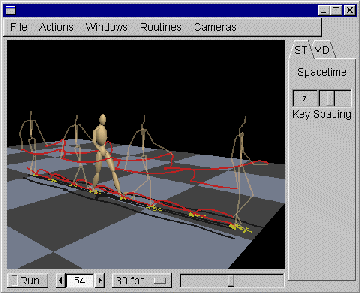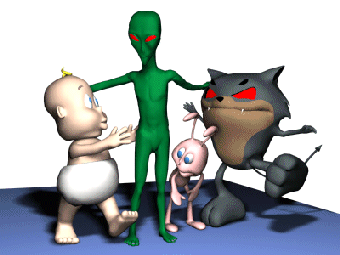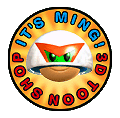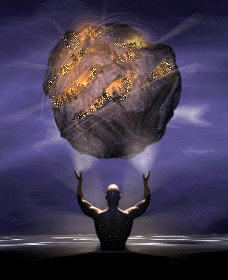|
Tools
and Resources
|
cSpacesdfsdfs Index Tools
and Resources Homemade
Software The software we used to do
the actual retargetting and constraint modification
is really the main workhorse for this project and
was written by Micheal Gleicher. The system reads
BVH (BioVision Hierarchy format) files and Python
scripts that specify the constraints. The program
uses OpenGL to draw the skeleton and the
constraints and the solver is quick enough to
resolve the motion in real time. This allows a user
to not only drag constraints around on the fly and
edit the motion, but also quickly add, remove, or
change constraints and resolve the motion very
fast. This step is very important
in the retargetting process to maintain an
acceptable motion. Due to size and proportion
differences in the original and new skeleton,
simply applying the motion to the new skeleton
would cause all sorts of nasty artifacts such as
skating feet. With our software the the solver can
create a new motion, keeping what is most
important, particularily solid footplants. Other
constraints can easily be added to control other
elements or to clean up the new motion. This is
discussed later. The
Models The models we used came from
various places. The baby and ant models were
provided to of by Hou Soon Ming, and our many
thanks go to him for allowing us to use his
fabulous models. His library of model can be found
at The Gremlin is from an
unknown author, but was downloaded from the
Virtual
Characters Archives Network
library of models. The alien we got from a CD
purchased from Zygote
Media Group.
The
Renderer To create our final renders
we used 3D Studio MAX version 2.5 and the Character
Studio 2 Plugin. The models were attached to
underlying skeletons using Physique and rendered
using the standard MAX renderer. For more information on 3D
Studio MAX visit the Kinetix web page at
www.ktx.com.


 .
.
